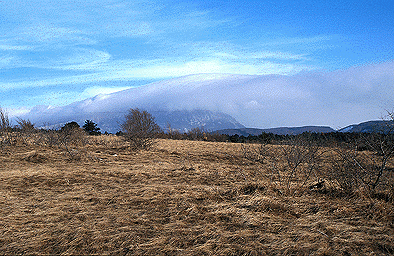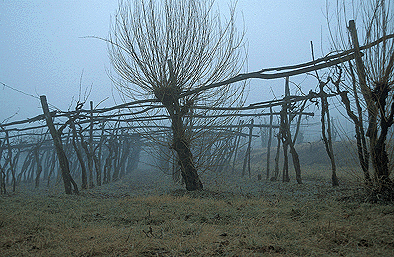Slovenia boasts numerous natural features and areas with well-preserved nature, which serve as shelters for a number of rare and endangered plants and animal species. These areas are also important as destinations for excursions and people’s relaxation at the end of the week. For many of them, protection in the form of regional or nature parks, nature reserves or monuments is planned. With this exhibition, we would like to present the riches of these areas also to the people who have not been acquainted with them as ye t and to contribute to a better understanding of their priceless value.
Although nature conservation efforts in Slovenia have been focused mainly on the Alpine world with Triglav National Park in the past, each Slovenian region has its own natural treasures and special features, which enrich the natural diversity of the country. We are embarking on a series of photographic exhibitions about Slovenian nature with a presentation of the warmest and most Mediterranean-like part of the country, i.e. the Slovenian part of Istria and the Motherland Karst with a capital letter K. There are signs everywhere that man has lived here since the ancient times. With his farming activities, however, he has transformed nature to a great extent and had a huge impact on the composition of the local fauna and flora. But when he thoroughly limited his activities in this stony, scanty land in recent decades, nature took control of the countryside once more. But urbanization is increasing and threatening to consume the very last nooks of the wilderness.
As life evolved in warm places, natural diversity is still the greatest in warm parts of the world. In Europe, this is the Mediterranean, while in Slovenia this is Primorska or the sub-Mediterranean region. The wealth of species here is so great that we don’t even dare to present all of the special features of the local fauna and flora. So we have chosen only a few representatives of plants and animals, with the basis of all living things being the bedrock and climatic conditions, which simply cannot be ignored.
Stone
The name for Karst has been preserved by newcomers adapting to the language of the new arrivals and originates from the word kar, meaning stone. This day it is hard to believe that the almost fully overgrown landscape was completely bare and rocky just half a century ago. Only in very rare places can we still find a bare stone surface where we can get an inkling of what the landscape looked like in the period when almost entirely settled by humans.
The Karst was laid bare already by the ancient sheep and goat shepherds, who by doing so created pastures for their animals. Now we have to make an effort to stray from the path into the bushes and discover along the tracks of roe deer and wild boar the landscape, which is interspersed with stone walls. These have always served to demarcate people’s property. In their thousands of years of management of the rocky landscape, they shifted an unknown amount of stones and stacked them in the walls that we now have to surmount while walking in the Karst. Here and there we can still find barren stony surfaces, eroded by weathering, which have been acting upon the stone ever since rising in the ancient times from below sea level. In some places, the remains of stones seem like the ruins of an ancient city. Elsewhere, grooves and fissures furrow the stone stacks that look like an old man’s wrinkled skin and remind us of the land’s ancient age.
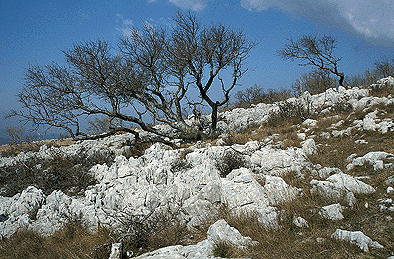
The immense pressure of the African tectonic plate on Europe, which caused the Alps to rise, was also the reason for the modern-day Karst Plateau rising from the sea. Due to the pressures, the rock layers were folded, broken and often stacked on top of each other, which is clearly visible in the area of the Kraški rob (Karst Edge). In many places, older limestones lie on much later-deposited flysch layers. As flysch weathers faster than limestone, the water in elevated areas washed it away. The limestone walls remain at the top, while flysch continues to weather in many pockets below. As it crumbles, bare scree slopes are formed, which are furrowed by water during heavy rains and on which plants find it difficult to survive. Facing the sun, the staircase-shaped threshold of the Karst is home to numerous heat-loving plants and animals. Overhanging rock walls protect Mediterranean plants from storms and bird nests from predators. On the edge of the rock, man built a whole series of forts and castles, of which only modest remains of walls have survived. The castle or fortress also stood in a cave under the overhanging Osp wall, which this day gives pleasure to just too many climbers.
In spite of the seeming inhospitality of the stony ground, the Karst was quite densely populated even before the arrival of the Romans. For safety reasons, the settlements were built in places with a good view. The mighty walls protected settlements in turbulent times, when all people were forced to take care of their own safety. Hilltops were mostly abandoned during the Roman occupation, but new villages grew up not far from them and are still alive today. While wandering around the Karst, we cannot avoid visiting the mysterious heaps of stones of the crumbling walls, which evoke our imagination. They were built by people who shaped the Karst cultural landscape and learned to live in this meagre world.
STONE SURFACE
Traces of the action of water, which cannot be seen on the surface, are visible everywhere. There is little rain in the Karst, while summers are usually completely dry. Water dissolves limestone with the aid of carbon dioxide, which dissolves in it and forms weak acid. Carbon dioxide is formed through the breathing of animals and plants. We, too, dissolve with our breath the stone, which are the remnants of ancient sea creatures living in shallow coastal seas during the Cretaceous and Tertiary periods. The water drains into the cracks, expands them, creates passages in the stone and flows through them towards the sea. Sinkholes, shafts and caves are formed. The work of the water was alleviated by tectonic movements, which folded and fractured the rock layers and allowed it to find its way into the underground.
THE REMAINS OF OUR ANCESTORS
The majority of hilltops and settlements from the Bronze and Iron Ages were built on top of the hills for defensive reasons. Around Gredina above Brestovica near Komen, a defensive wall made of Karst stones can still be admired. Unfortunately, the remains were damaged by soldiers when fortifying the front line which during World War I led over the top of the hill. September 2002
The walls of the Martinišče hilltop above Sveto once protected the inhabitants; today, it is overgrown with bushes. April 2001
USE OF STONES
Water
Running water can be found on the surface only on the periphery of the Karst. It flows from the flysch-bedded mountains of Brkini in numerous streams, but their above-ground course ends in dead-end valleys of the Matarsko podolje. Here they disappear into the underground and supply the groundwater hidden in the depths of the Karst.
The Reka River, which springs from below Mt Snežnik, flows through the flysch valley until reaching the limestone at Gornje Vreme. It carved an attractive gorge into it, which ends below the village of Škocjan, where it disappears underground for the first time. The disappearance of such a large river into the underworld has always stirred people’s imagination, which is probably the reason why there were sanctuaries above the sinkholes from ancient times, and why people buried their dead here, at the entrance to the afterlife.
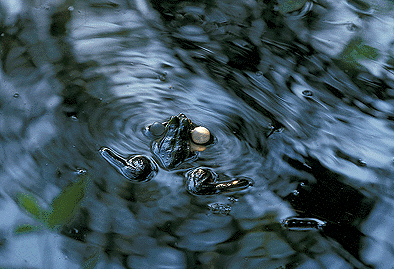
Together with the water, numerous animals moved underground and through time adapted to the perpetual darkness and scanty food sources. They lost their eyes as well as dyes they did not require to sharpen their other senses. Crabs, arachnids, beetles and even the largest amphibious olm inhabit the underground world of the Slovenian Karst. The caves are also home to bats, whose droppings provide an important source of nutrients that sustain the cave fauna, which is dependable only on the water that carries nutrients to them from the surface.
The Karst surface is constantly subsiding owing to weathering and washing out. When the Karst sinkholes subside right to the water table or water courses, they get flooded during high water levels. Intermittent lakes are formed, which retain water only for part of the year, but when it drains away, plants that have successfully survived this period under water begin to flourish. Only few such plants exist, so we can admire the carpets of the same flower species on the former lake bed. There are many small intermittent lakes in the Pivško area below Mt Javorniki. The largest of them are Petelinjsko and Palško lakes, while on the other side of Mt Javorniki spreads the most famous intermittent lake: Cerkniško jezero (Lake Cerknica). There is no surface water in the central Karst, as despite the rather abundant precipitation in the autumn and spring, it all sinks underground. The locals therefore depended on the rainwater collected in wells, and in every village, they also had karst ponds, i.e. shallow basins with impermeable bottoms, in which the water used for watering livestock was kept. Water from deeper water reservoirs, called pools, was once used even for drinking.
WATER IN THE KARST
The Brsnica stream, which comes flowing from the flysch-bedded Brkini, disappears underground at the end of a blind valley, in the swallets of Odolina. There are a number of other similar blind valleys on the edge of the karst Matarsko podolje. May 2000
The Branica stream flows parallel to the northern edge of the Raški fault. Its tributary is the torrential Raša, which is dry for the greater part of the year, and receives the bulk of its waters from the flysch-bedded Vipava Hills. Through the valley it still flows by following its natural meanders. On the outside it washes away its former debris, while on the inside it deposits new ones. The belts along the water are inhabited by hygrophilous plants and animals, which are otherwise not found in the Karst. Common Water Striders move along the surface of the water with their long legs, waiting for the current to bring them something edible. The Branica stream flows into the Vipava Valley, where it joins the Vipava River.
In time past, every village in the Karst had springs and pools where rainwater was collected. Something special are the karst ponds at Brestovica pri Povirju, since they boast a natural inflow of underground water during high water levels. The largest pond is Globočaj, but the water reservoirs at nearby Studence are interesting, too. Here we can see three excavated and walled water reservoirs. After heavy rains in winter and spring, water springs up in the upper two reservoirs and flows into the third one, from where it drains into a nearby sink, where it disappears underground.
ŠKOCJAN CAVES
The Reka River, which finds its source below Mt Snežnik, disappears into the mysterious underground in the Škocjan Caves. The fact that the water reappears in the Timavo springs in the Gulf of Trieste was known already by ancient writers. However, its flow underground is far from simple and cannot be followed everywhere. From time to time, the water also changes its course when finding a new rift. Some time ago, a pitch opened in its channel near Gornje Vreme, and the Timavo plunged into it. It was only after heavy rains that it clogged it with sediment to such an extent that it began to flow into the Škocjan Caves again. On a rock above the Reka River Gorge stood Školj Castle, of which only ruins now remain. There are also the remains of mills along the water.
In its underground course, the Reka River formed huge underground halls and gorges, which made the Škocjan Caves so very popular and famous. In two places, the ceilings of the halls became so thin that they collapsed, creating the Little and Big Valleys, the collapse dolines with more or less vertical walls. Between them, the river flows under a mighty natural bridge. In the shadow of the valleys, some alpine plants proliferate, such as the Bear’s Ear, while not far from it the Mediterranean Maidenhair Ferns can be admired as well. Alpine Swifts (Tachymarptis melba), which nest in crevices, can be seen flying along the walls and, if we are lucky, we can catch sight of the red-winged Wallcreeper (Tachodroma muraria) in winter.
INTERMITTENT LAKES
After heavy rains that generally come in autumn and spring, karst poljes become flooded with water from karst springs. It drains underground again through sinks in the karst ground, causing the lake to dry up when the water inflow decreases or dries up.
Wind
Once the cold front passes over, great differences in air temperature occur along the sea and on cold mountain plateaus. Cold air is denser and heavier than warm air, which means that it displaces it and falls from the mountains across the Karst towards the sea. Sometimes it reaches even hurricane speeds, which is the reason why karst houses are turned with their backs to it and built tightly together. The locals love the bora, since it brings fresh air and nice weather. It also dries the prosciutto, pancetta, salami and other Karst delicacies. When the cold air, saturated with water droplets, blows from Trnovski gozd and Mt Nanos into the warm valley, it warms up and absorbs moisture. The drops evaporate and so do the clouds. When a strong gale blows, we see well stretched clouds on the mountain ridges, with the sun sending its rays on the Karst. The cold bora prevents large stands of true Mediterranean vegetation from growing in the Karst and along the coast. The name for the bora is a transliteration of the Latin term borea, meaning northerly wind.
Snow falls on the Karst very rarely and never lasts long. During the day, at least, the sun warms the ground to such an extent that the snow melts, or is blown away by the bora. Cold bora, however, thoroughly cools the soil during cold winter nights, and it is not uncommon for sleet to form with rain falling on the cold ground and freezing, encasing the entire vegetation in icy armour.
AIRED GRASSLANDS
While the lower areas of the Karst are already heavily overgrown, the peaks exposed to the bora are still partially grassy at least. Upland stony grasslands have only a thin layer of soil, which is severely dried by the dry wind. Consequently, trees grow largely in sinkholes with more soil in them, and behind rock edges that protect them from the bora wind.
If we visit the karst peaks at the time when we are literally blown down into the valley, we can easily blame the bora for the slower overgrowth of the top slopes in the High Karst. Even by the growth of isolated trees, which are bent in the direction of the bora, we can easily recognize the dominant role of this force of nature. Wind severely dries out trees and the soil further increases the effects of summer drought. The bora is the strongest in winter. Owing to the high altitude, the karst peaks are cooler than the lowlands. The ground is frozen and plants are unable to draw moisture from it. Grassland plants, which hide their vital organs in the ground, are not affected by this. The branches and trunks of trees, however, can be dried by the bora to such an extent that the trees die. The effect is similar to the effect reached in steppes with the continental climate by hot summers and cold snowless winters. Milder winters and weaker bora winds, as prevalent in recent years, will probably hasten the overgrowth of grasslands.
The wind, which has over the centuries maintained or kept alive the grasslands in the karst mountains and the seething life in them, will unfortunately also be the cause of the grasslands’ mutilation or destruction. Our civilization simply cannot do without electricity and the use of wind energy with the aid of giant windmills is a new threat to pristine nature. After the period when industrialization destroyed nature in the valleys, it is now expanding and spreading with wind farms and power lines to the still now better preserved hills.
Life
When looking at the Karst these days from a hill, we see a wooded landscape, from which only karst villages perched on the top of the slopes are peeping. Up close, however, the Karst reveals its meadows and pastures intertwined with young forests like laces. But from year to year there are fewer of them, with the forests constantly encroaching upon and overgrowing the remains of grass.
The Karst was for quite some time considered an inhospitable stone desert, ruled by the bora wind. Afforestation began to be practiced in the 19th century by the Austrians, who ruled the Karst at that time. The locals disliked it, as this was taking up their space and changing the climate, which was becoming increasingly humid, with the bora losing its strength. Afforestation was difficult, as the trees had difficulty taking root on the rocky slopes. The most successful in this respect turned out to be the Austrian Pine, which was not a wild-growing plant in the Karst. Over fifty years old photos still show the bare stone surface, where forests are growing today. The turning point in the Karst’s development was the prohibition of sheep and goat breeding after World War II. The forests gradually began to grow naturally and are still expanding. The predominant trees in the Karst’s wild forests are the European Hop-hornbeam, Downy Oak and Manna Ash, while in higher areas the Beech prevails as well.
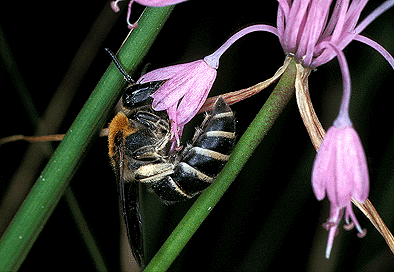
Coral reefs in tropical seas are considered, together with their corals and colourful fishes, the pinnacle of natural diversity, the same as the tropical rainforest, which still hides a multitude of still undescribed animal and plant species. Neither of them can be found in Slovenia, but if you wish to observe natural diversity in all its glory, then go and see the stony grasslands and overgrown village commons. Instead of corals, the basis of food chains here is the great diversity of plants. On stony ground with scarce soil there proliferate other species than on deeper ground, which is already overgrown with bushes and trees. In March, the Karst is dominated by yellow shades, such as Dogwood in the midst of bushes, and Cinquefoils on rocky pastures. Among the first to bloom are plants with bulbs, rhizomes or tubers, which draw strength for their colourful flowers from underground reserves. Before the summer drought, they have to complete their development and produce seeds for the development of a new genus. The tiny blue flowers of the Common Grape Hyacinth bloom as early as March. Among the dry grass, a little later, the shy Meadow Anemones are nodding, turning towards the ground, as if ashamed to display their dark purple flowers under the furry down that protects them from the cold. In April, the blooming Mahaleb Cherries colour the village commons white, where joined by the Poet’s Daffodils. As if they wished to create the illusion of a snowed up landscape, which can seldom be seen here in winter. The Illyrian Irises usually bloom during the May Day holidays, while a little later the Burning Bushes show off the beauty of their pink flowers around the shrubbery. You have to be lucky to find the Slender Fritillary, since this relative of the Snake’s Head Fritillary is rare. Many lawns turn silver upon sunlight getting caught in the fluffy fringes of the Needle Grasses. Yet we are most delighted when catching sight of the big red flowers of the Peony behind a bush.
Plants are the primary source of food for a multitude of incredibly diverse insects, from grasshoppers, beetles and caterpillars that nibble on them, to bees living in symbiosis with them. Insects are the source of food for reptiles, especially the Dalmatian Wall Lizard, frogs and birds. Some birds, which have almost disappeared elsewhere owing to environmental changes brought about by modern agriculture, are still common in the Karst.
The great diversity of life in the Karst is the consequence of its position on the edge of the Mediterranean. The latter is the species-richest part of Europe and one of the hotspots of life diversity on the planet. These hotspots are home to most endemic, original plant and animal species, i.e. the greatest share of natural diversity. The diverse geological history of the Mediterranean region and the fact that numerous species found refuge in it during the cold Ice Ages are the cause for the expeditious evolution of life forms in this region. Since the Karst is situated on the border of these two faunal regions, western and eastern Mediterranean species can be found here. Furthermore, it is situated at the junction of the Mediterranean and continental regions, which is the reason why it is inhabited by the occupants of both. At some point in the distant past, a connection with the Eastern European steppes had to exist, as corroborated by the presence of some species. The mosaic interweaving of grassland and forest communities additionally enriches the Karst, for it is inhabited by both grassland and forest species. The moment when grasslands are relinquished to develop and, in turn, to become overgrown, is certainly the most hospitable to most plants and animals.
KARST GRASSLAND PLANTS
KARST GRASSLAND ANIMALS
The Southern Festoon (Zerynthia polyxena) at Brje near Komen, April 2000. In spring, this colourful butterfly, which is considered an endangered species in Europe, can be seen flying all over the Karst. Its caterpillar feeds on Dutchman’s Pipes, which flourish on forest edges, in overgrown meadows and along trails.
The karst meadows swarm with various grasshoppers, one of the main herbivores in dry grasslands, where some carnivorous species can also be found. Quite common among the tall grass are the European Locusts (Metrioptera kuntzeni), endemic long-thumbed insects, first described on the basis of specimens from Mt Učka, the highest mountain in Istria.
PLANTS OF SHRUBS AND FORESTS
ANIMALS OF SHRUBS AND FORESTS
The male Stag Beetle (Lucanus cervus) is adorned with powerful "horns", the large jaws with which it fights against its rivals. Brje near Komen, June 1997. Oak wood is a source of food for Stag Beetle larvae, which fly around during June and July evenings searching for females.


